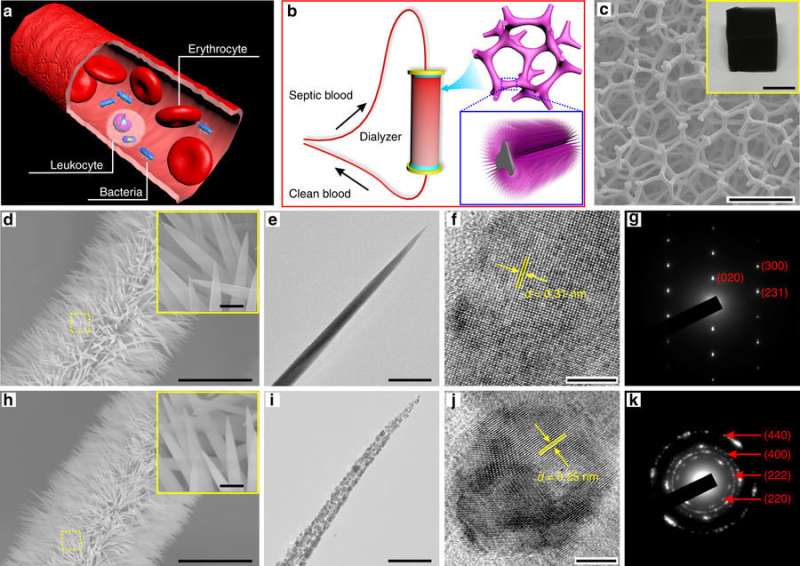February 13, 2018 report
Claw-like nanowires filter bacteria from blood

A team of researchers from institutions across China has developed a new type of dialyser —one capable of capturing up to 97 percent of bacteria present in a blood sample. In their paper published in the journal Nature Communications, the group explains the origins of their device, how the filter was made and how well it worked during testing.
While most people are familiar with bacterial infections that appear on or near the skin, there are other types that occur inside of the body. One of the most dangerous situations is when bacteria multiply in the bloodstream—a circumstance that can lead to sepsis. Currently, such infections are treated with antibiotics; if they do not work, the next step is to connect a patient to a dialyser —a machine that filters the blood, removing bacteria. Unfortunately, as the researchers note, current dialysers are not very good at filtering bacteria and patients suffer as a result. In this new effort, the researchers have developed a new type of dialyser that they claim does a far better job.
The idea for the new dialyser, the team notes, came from the Venus flytrap—it has tiny hairs that curl and trap prey. To create a dialyser with a similar dynamic, the researchers built a substrate of 3-D carbon foam and implanted a host of flexible polycrystalline nanowires inside of it. Prior research by the team suggested that the nanowires would bend and trap bacteria in a way similar to the hairs on the flytrap. The researchers tested the dialyser by pushing blood through the filter and then noting reductions in blood bacteria levels. They examined the filter to note how many were captured by the nanowires.
The researchers report that their filter was 97 percent effective in capturing bacteria in blood samples moving at rates similar to those inside the body. They note that their work is still at the proof-of-concept stage and thus more work is required to make sure that the filter does not cause other problems while filtering bacteria. But they describe their device as a major step forward, and plan further tests to see if it might also be used to filter out other microorganisms, such as cancer cells or viruses.
More information: Lizhi Liu et al. Bacterial capture efficiency in fluid bloodstream improved by bendable nanowires, Nature Communications (2018). DOI: 10.1038/s41467-018-02879-9
Abstract
Bacterial infectious diseases, such as sepsis, can lead to impaired function in the lungs, kidneys, and other vital organs. Although established technologies have been designed for the extracorporeal removal of bacteria, a high flow velocity of the true bloodstream might result in low capture efficiency and prevent the realization of their full clinical potential. Here, we develop a dialyzer made by three-dimensional carbon foam pre-grafted with nanowires to isolate bacteria from unprocessed blood. The tip region of polycrystalline nanowires is bent readily to form three-dimensional nanoclaws when dragged by the molecular force of ligand-receptor, because of a decreasing Young's moduli from the bottom to the tip. The bacterial capture efficiency was improved from ~10% on carbon foam and ~40% on unbendable single-crystalline nanowires/carbon foam to 97% on bendable polycrystalline nanowires/carbon foam in a fluid bloodstream of 10 cm s−1 velocity.
Journal information: Nature Communications
© 2018 Medical Xpress


















